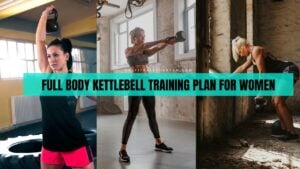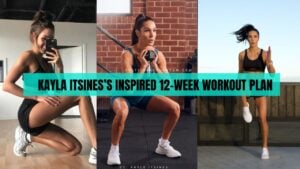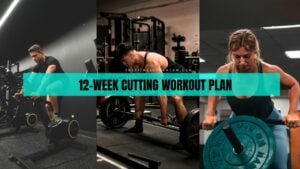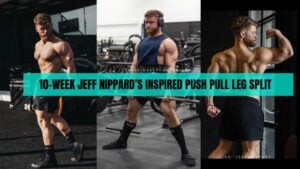Whether you’re a beginner, intermediate, or advanced, if you’re looking for the best calisthenics exercises to train your lower body, you’ve come to the right place.
From basic to advanced, I’ve shared as many as 20 best calisthenics leg exercises in this article that will help you improve your strength, power, endurance, balance, and flexibility.
Depending on your fitness level, you can pick different exercises and include them in your workout program.
You can do the lower body calisthenics exercises anywhere at any time because they require no additional equipment, only your own body weight, a workout bench for some movements, and some little space where you can hop and lay down.
Okay! So, let’s look at the exercises and how to do them step by step.
Also Read: Calisthenics Exercises List for each Muscle Group
Calisthenics Leg Workout for Beginners
- Wall Sits
- Standard Squat
- Lateral Lunges
- Step-up
- Glute Bridge
- Standing Calf Raises
1. Wall Sits

| Muscles Worked | Focus | Suggested Reps |
|---|---|---|
| Quads and Glute | Strength and Balance | 6-8 |
The wall sits are low-impact and effective exercises that are great for beginners to start with. It works on the lower body and helps increase your strength and endurance for other lower-body calisthenics exercises.
How to: Sit against the wall with your back and glutes rested on it and keep your feet flat on the floor. Brace your abdominal muscles and thighs and stay in that position for 10 to 15 seconds.
2. Standard Squat

| Muscles Worked | Focus | Suggested Reps |
|---|---|---|
| Quads | Strength | 15-20 x 3 |
The standard bodyweight squat is a basic exercise for strengthening lower extremists, particularly the quadriceps. It helps build muscles, lower body fats, and scale your fitness to the next level so you can perform intermediate and hardest calisthenics leg workouts.
How to:
- Stand upright in the shoulder-width stance with your feet pointing slightly out.
- Keep your back straight and chest up, and lower into a squat position until your thighs are parallel to the floor.
- You can go down as deep as you like as long as you maintain the proper form.
3. Lateral Lunges

| Muscles Worked | Focus | Suggested Reps |
|---|---|---|
| Quads, Hams, & Glutes | Strength, Balance, & Flexibility | 10-12 x 3 |
Lateral lunges are a great exercise to improve your hip and thigh strength. They also help you work on your balance, core stability, and coordination.
It’s a perfect exercise for beginners as it helps strengthen your strength and help you do more advanced leg exercises.
How to:
- Stand upright with your feet together and arms bent in front of your chest.
- Keep your right foot flat on the floor and knee straight, and take your left foot out to the side as far as possible.
- Pushing your hips back, bend your left knee to lower your body until your glute is parallel to the floor. Your right foot should remain planted on the floor.
- Pressing your left foot, extend your knee, and return to the start. That’s your one rep.
- Perform an equal number of reps and sets on each side.
Note: You can use lateral lunges alternatively.
4. Step-up
| Muscles Worked | Focus | Suggested Reps |
|---|---|---|
| Quads, Hams, & Glutes | Strength and Endurance | 10-12 x 3 |
The step-up is a highly effective leg exercise that you can incorporate into your calisthenics lower body workout training.
Other than strengthening the quad, hamstrings, and glutes, a study suggests that step-up movements like stair climbing and chair rise help improve muscle power and functional ability as well as prevent age-related health conditions such as sarcopenia in older women.1 Mair JL, De Vito G, Boreham CA. Low Volume, Home-Based Weighted Step Exercise Training Can Improve Lower Limb Muscle Power and Functional Ability in Community-Dwelling Older Women. J Clin Med. 2019 Jan 4;8(1):41. doi: 10.3390/jcm8010041. PMID: 30621121; PMCID: PMC6352105
So, it’s best to constantly perform this movement with other exercises to achieve maximum strength, power, mobility, and pliability.
How to:
- Stand upright against a box or a flat bench.
- Step your right foot on the box, followed by the left one.
- Once you stand on the box, lower your legs one by one on the floor. That’s your one rep.
- Keep your chest up and maintain a flat back during the entire movement.
5. Glute Bridge

| Muscles Worked | Focus | Suggested Reps |
|---|---|---|
| Glutes and Hips | Strength and Mobility | 10-12 x 3 |
The Glute bridge is a great exercise to strengthen your backside. It also reinforces other muscles, such as hamstrings, abdominals, hips, and lower back.
It is suitable for beginners as it is low impact, easy to perform, and requires no equipment; you can do it anywhere, anytime.
How to:
- Lie supine on the floor with your knees bent and feet flat on the floor.
- Brace your core and glutes, and thrust your hips upward as high as possible.
- Pause for a moment, and then lower your hips on the floor. This is your one rep.
6. Standing Calf Raise
| Muscles Worked | Focus | Suggested Reps |
|---|---|---|
| Calves | Strength and Mobility | 15 x 3 |
It is an isolation leg workout that particularly strengthens your calves. It’s good for building sturdy legs and increasing strength in the lower body.
You can perform calf raises anywhere you like, but doing it with the support of a standing object, such as the wall, provides balance and allow you to perform the movement efficiently.
Steps to perform the standing calf raises:
- Stand against the wall, take your arms out, and place your palms on the wall.
- Slightly lean forward while maintaining a neutral spine.
- Brace your thighs and lift your heels off the floor as high as possible so you can feel the stretch in your calf muscles.
- Lower your heels back on the floor and repeat for the desired number of times.
Intermediate Calisthenics Exercises for Legs
- Jump Squat
- Bulgarian Split Squat
- Reverse Lunge
- Curtsy Lunges
- Glute Kickback
- Back and Forth Lunges
- Jumping Split Lunges
- Elevated Glute Bridge
7. Jump Squat
| Muscles Worked | Focus | Suggested Reps |
|---|---|---|
| Lower Body | Strength, Power, & Endurance | 10-12 x 3 |
Jumping squats are a strength and endurance-building exercise. They are fast and great for developing explosive power. They also burn decent calories in a short time and tone thighs and glute muscles.
The jump squat is generally included in the calisthenic leg exercises to help you gain ultimate power, endurance, and balance.
How to:
- Start in a standing position with your feet shoulder-width apart and arms bent in front of your chest.
- Lower into a partial squat (do not let your hips go below your knees) and then jump explosively as high as you can. Your arms will swing back as you jump.
- Land softly on the floor and repeat for the desired number of reps and sets.
8. Bulgarian Split Squat

| Muscles Worked | Focus | Suggested Reps |
|---|---|---|
| Lower Body | Strength, Balance, & Stretching | 10-12 x 3 |
The Bulgarian split squat activates almost every lower body muscle, such as the quads, hamstrings, hips, and glutes maximus, and builds strength and mobility.
How to:
- Standing upright behind a flat workout bench, lift your right leg off the floor and place the top of your rear foot on a bench behind you.
- Keep your torso upright and brace your abdominal muscles. That’s the starting position.
- Bend your knees to lower into a squat until your rear knee comes close to the ground.
- Pressing through your leading foot, extend your knee. That’s one rep.
9. Reverse Lunge
| Muscles Worked | Focus | Suggested Reps |
|---|---|---|
| Lower Body | Strength and Mobility | 10-12 x 3 |
The reverse lunge is a variation of the classic lunge. The difference is that you will step back with one leg instead of forward during this movement.
It’s an excellent exercise for improving balance and stability and bolstering your quadriceps, hamstrings, and glute muscles.
How to do it:
- Start upright with your feet together.
- Step back to your right leg, landing on the ball of your foot, and bend both your knees until the right knee almost touches the ground (or just below).
- Push off from your front foot to return to the standing position.
Note:
- Keep your core tight, chest up, and shoulder slightly down during the movement.
- You can hold your hands on your hips to keep it stable.
10. Cursty Lunges/Squat
| Muscles Worked | Focus | Suggested Reps |
|---|---|---|
| Lower Body | Strength and Mobility | 10-12 x 3 |
The cursty lunge is one of the variations of lunges that helps forge lower body muscles as well as increase balance and flexibility. It is also an effective way to build up strength for other calisthenic leg workouts.
How to:
- Standing upright in the hip-width stance, lift your right foot off the floor and cross it behind your left leg as you bend your knee to squat down until your hip is in a normal squat position.
- Drive through your left foot to return to the start and repeat on the opposite side. That’s one rep.
11. Glute Kickback
| Muscles Worked | Focus | Suggested Reps |
|---|---|---|
| Gutes, Lower Back, and Core | Strength and Mobility | 10-12 x 3 |
If you want to strengthen your glutes while increasing the stability of your core and lower back muscles, then glute kickback is for you.
The glute kickback is convenient and easy to execute. It engages all the lower body muscles except the quadriceps.
It is suitable for all fitness enthusiasts and can be a good addition to the lower body calisthenics workout.
How to do it:
- Sit on all fours with your arms straight underneath your shoulders and knees below your hips.
- Maintain a neutral spine position and brace your abdominal muscles.
- Lift your right knee off the floor and kick your leg upward until you feel the contraction in your glutes.
- Pause for a couple of seconds and return your knee to the floor.
- Perform the desired reps and switch on the left side.
12. Back and Forth Lunges
| Muscles Worked | Focus | Suggested Reps |
|---|---|---|
| Lower Body | Strength, Endurance & Mobility | 8-10 x 3 |
It is more challenging than the standard lunges because they are fast and require more stability and balance.
It is a great exercise for building up your legs, hips, and glutes and helping you advance your athletic fitness.
Try this variation to get maximum results once you get bored of traditional lunges.
How to: To perform the back-and-forth lunges, bring your right foot behind and make a reverse lunge, and then bring your right leg forward and make a front lunge and repeat the same on the opposite side.
13. Jumping Split Lunges
| Muscles Worked | Focus | Suggested Reps |
|---|---|---|
| Lower Body | Strength, Speed, & Endurance | 8-10 x 3 |
If you want to increase your strength, balance, and speed, consider doing jumping split lunges.
Jumping split lunges engages all muscles throughout the lower body and makes your legs strong and athletic.
How to:
- Stand straight with your feet together, head high, and chest up.
- Jump your feet off the floor and land into a lunge position with your knees bent and close to the floor.
- Again, jump back and drop into the lunge position on your opposite side.
- Perform as fast as you can while maintaining a proper form.
14. Elevated Glute Bridge
| Muscles Worked | Focus | Suggested Reps |
|---|---|---|
| Glute and Hamstring | Strength and Mobility | 8-12 x 3 |
The elevated glute bridge is an excellent exercise to strengthen the glutes and hamstrings. It also improves hip stability, which can help prevent lower back pain and other injuries.
How to:
- Lie supine on the floor in front of an elevated object, such as a flat bench.
- Lift your feet and place the heels on the bench. Keep your arms straight at your sides. This is your starting position.
- Brace your abdominal and glute muscles and lift your hips off the floor until they are aligned with your knees.
- Pause for a moment, and then return your hips to the start. That is your one rep.
Lower Body Advanced Calisthenics Exercises
- Pistol Squat
- Knee Jump
- Skater Squats
- Archer Squats
- Sissy Squats
- Single Leg RDL To Reverse Lunge
15. Pistol Squat

| Muscles Worked | Focus | Suggested Reps |
|---|---|---|
| Lower Body | Strength, Balance & Flexibility | 8-10 x 3 |
The pistol squat is a unilateral leg exercise, meaning you perform the squat on one leg. It strengthens various muscles throughout the lower body, including hamstrings, quads, hips, and glutes. It also engages the core and helps improve body awareness.
How to:
- Stand straight with your feet hip-width apart.
- Keep your hands in front of your chest with your elbows bent.
- Lift your right leg off the floor and bring it in front of you as you lower into a squat position.
- When your glute is parallel to the floor, pause for a moment, and then push through your heel to get back into the standing position.
Pro Tips:
- Keep your torso as straight as possible during the squat.
- Try to keep your core muscles engaged throughout the movement.
16. Kneeling Jump
| Muscles Worked | Focus | Suggested Reps |
|---|---|---|
| Lower Body | Strength, Balance & Speed | 8-10 x 3 |
The kneeling jump is a part of plyometric training that is great for developing athletic performance, especially for football, basketball, and baseball players.
It helps develop power, agility, strength, and endurance and bolsters the lower parts of your body.
Combining this movement with other best calisthenic leg exercises helps you achieve the maximum results over time.
How to:
- Standing on your knees, jump in the air with your arms swinging back.
- Land on your feet in the squat position.
- Extend your knees to stand upright.
- Stand on your knees again and repeat for the desired number of times.
17. Skater Squat (Single-Leg Squat)
| Muscles Worked | Focus | Suggested Reps |
|---|---|---|
| Legs | Strength, Balance & Pliability | 8-10 x 3 |
The skater squat is an excellent exercise to improve your balance, body awareness, and flexibility, as well as forge lower extremists.
Research has shown that unilateral skater squat strengthens the hamstring, calf, hip, and abdominal muscles without putting much stress on your lower back. It can also be used as a rehabilitation exercise to treat low back pain.2 Eliassen W, Saeterbakken AH, van den Tillaar R. COMPARISON OF BILATERAL AND UNILATERAL SQUAT EXERCISES ON BARBELL KINEMATICS AND MUSCLE ACTIVATION. Int J Sports Phys Ther. 2018 Aug;13(5):871-881. PMID: 30276019; PMCID: PMC6159498.
How to: Stand upright on your right leg, bend your left knee, and keep your arms straight before you. Pushing your hips back, lower into a squat position in a controlled manner until your left knee touches the floor, and then return to the starting position. Your back should remain flat and core tight during the entire movement.
18. Archer Squat
| Muscles Worked | Focus | Suggested Reps |
|---|---|---|
| Legs | Strength, Balance & Pliability | 8-10 x 3 |
The archer squat is another excellent strengthening and mobility exercise. It reinforces various muscles simultaneously, such as the thigh and hips, provides a good stretch to your leg muscles, and improves your flexibility.
How to perform archer squat: Stand upright with your feet two times wider than shoulder width. Pushing your hips toward your right side, bend your right knee until your glute is parallel to the floor. Your left leg will be stretched as you lower into a squat position to your right side. Push yourself up again into the starting position and repeat on the opposite side.
19. Sissy Squat
| Muscles Worked | Focus | Suggested Reps |
|---|---|---|
| Legs | Strength, Balance & Flexibility | 8-10 x 3 |
The sissy squat is one of the hardest calisthenics exercises for legs that help improve strength, balance, and muscle coordination.
It requires you to lean back and perform the squat on the balls of your feet.
It challenges your stability and ability to control the movement of your body.
So if you’re doing calisthenics workout for a while, you should include this movement into your workout program.
How to:
- Stand upright in the hip-width stance and hold your arms straight in front of your chest. Maintaining a neutral spine position, lean your torso back and bend your knees simultaneously until your heels are off the floor and your knees are in line with your ankles.
- Pause for a second and return to the starting position. That’s one rep.
- You can also do supported sissy squats by holding a standing object with one hand.
20. Lunges to Single Leg RDL
| Muscles Worked | Focus | Suggested Reps |
|---|---|---|
| Legs, Back, and Core | Strength and Mobility | 8-10 x 3 |
Lunge to single-leg RDL is an excellent exercise that increases strength, balance, and flexibility. It works on various muscles throughout the body, such as the legs, hips, butt, lower back, and core, and helps strengthen and tone muscles.
How to:
- Stand upright with your feet together and perform a reverse lunge.
- Bend your torso forward and raise your right leg behind simultaneously until your chest and thigh are parallel to the floor.
- Pause for a second, return to the start, and repeat on the opposite side.
The Best Calisthenics Leg Workout Routine
Beginner – Perform two rounds in the circuit
| Exercise | Reps | Rest |
|---|---|---|
| Wall Sits | 8-10 | 45-sec |
| Standard Squat | 15-20 | 60-sec |
| Lateral Lunges | 8-12 | 60-sec |
| Step-up | 8-12 | 60-sec |
| Glute Bridge | 10-12 | 45-sec |
| Standing Calf Raise | 12-15 | 45-sec |
Intermediate – Perform three rounds
| Exercise | Reps | Rest |
|---|---|---|
| Jump Squat | 10-12 | 30-sec |
| Bulgarian Split Squat | 8-10/side | 45-sec |
| Pistol Squat | 8-10/side | 60-sec |
| Curtsy Lunges | 8-10/side | 60-sec |
| Archer Squats | 8-10/side | 60-sec |
| Elevated Glute Bridge | 8-12 | 60-sec |
Advanced – Perform three rounds
| Exercise | Reps | Rest |
|---|---|---|
| Jumping Split Lunges | 8-12 | 45-sec |
| Kneeling Squat Jump | 8-12 | 1-min |
| Skater Squats | 8-10/side | 1-min |
| Archer Squats | 8-10/side | 1-min |
| Curtsy Lunges | 8-10/side | 1-min |
| Sissy Squats | 8-10/side | 1-min |
| Elevated Glute Bridge | 8-12/side | 1-min |
| Lunges to Single Leg RDL | 8-10/side | 1-min |
The Bottom Line
I’ve outlined the 20 best calisthenics exercises for legs that can help you build from strength and stretching to balance and agility.
They also help you improve your body awareness, muscle coordination, and abdominal strength, correct poor posture, as well as reduce the risk of injuries.
You can select a few exercises that match your fitness level and include them in your workout program.
If you’re a beginner, perform each exercise and try some of the hardest ones to improve your overall fitness over time.
And, if you have been working out for a while, it’s best to modify any exercise and make it more challenging.
References
- 1Mair JL, De Vito G, Boreham CA. Low Volume, Home-Based Weighted Step Exercise Training Can Improve Lower Limb Muscle Power and Functional Ability in Community-Dwelling Older Women. J Clin Med. 2019 Jan 4;8(1):41. doi: 10.3390/jcm8010041. PMID: 30621121; PMCID: PMC6352105
- 2Eliassen W, Saeterbakken AH, van den Tillaar R. COMPARISON OF BILATERAL AND UNILATERAL SQUAT EXERCISES ON BARBELL KINEMATICS AND MUSCLE ACTIVATION. Int J Sports Phys Ther. 2018 Aug;13(5):871-881. PMID: 30276019; PMCID: PMC6159498.






